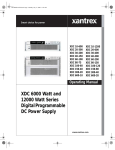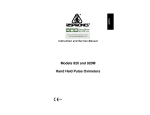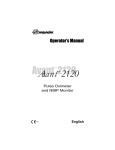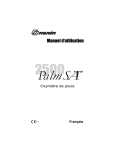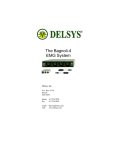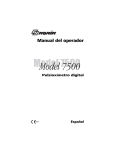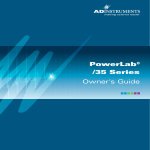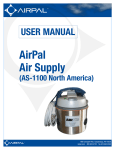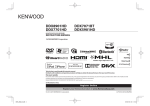Download Delton Fingertip Oximeter Service manual
Transcript
English Instruction and Service Manual Model 950 Finger Pulse Oximeter 0459 About the Manual Shaded boxes draw attention to contraindications, warnings, cautions and notes. The information in this manual has been carefully checked and is believed to be accurate. In the interest of continued product development, RESPIRONICS, INC. reserves the right to make changes and improvements in this manual and the products it describes at any time, without notice or obligation. Caution: Federal Law (USA) restricts this device to sale by or on the order of a physician. Respironics Georgia 175 Chastain Meadows Court Kennesaw, Georgia 30144-3724 USA Telephone: 1-770-499-1212 Fax: 1-770-499-0117 Customer Service Telephone: 1-800-345-6443 (USA and Canada) Customer Service Fax: 1-800-886-0245 (USA and Canada) www.respironics.com Respironics Deutschland Gewerbestrasse 17 82211 Herrsching Germany Telephone: 49 815 293 060 Fax: 49 815 293 0618 Respironics Asia Pacific 3/F, Microtron Building 38 Hung To Road Kwun Tong, Kowloon, Hong Kong Telephone: 852-2771-1886 Fax: 852-2770-7557 is a registered trademark of Respironics, Inc. Copyright © 2002 Respironics, Inc. All rights reserved. iii English The boxed messages are important. Be sure to read them. Table of Contents Description................................................................................... 3 The 950 at a Glance ..................................................................... 4 Intended Use ................................................................................ 6 Operating Instructions............................................................ 7 Getting Started ............................................................................. 7 Lanyard and Lanyard Lock.......................................................... 8 Battery Requirements .................................................................. 9 Inserting New Batteries.............................................................. 10 Activating the 950...................................................................... 11 Verifying Operation................................................................... 12 Conditions That May Affect Use ............................................... 13 Maintenance........................................................................... 14 Storage Requirements ................................................................ 14 Theory of Operation ............................................................. 16 Oximetry .................................................................................... 16 950 Averaging............................................................................ 18 Specifications ......................................................................... 19 Parts and Accessories............................................................ 20 Parts ........................................................................................... 20 Accessories ................................................................................ 20 Technical Support ...................................................................... 20 Warranty................................................................................ 21 Troubleshooting Guide ......................................................... 22 v English Contraindications, Warnings, and Cautions ........................ 1 Introduction ............................................................................. 3 Figures Figure 1. Top digital display illustration and bottom label. .... 4 Figure 2. Lanyard and lock. .................................................... 8 Figure 3. Inserting new batteries........................................... 10 Figure 4. Applying the 950. .................................................. 11 Figure 5. Maintenance choices.............................................. 15 Glossary of Symbols SYMBOL DEFINITION OF SYMBOL Attention, Consult ACCOMPANYING DOCUMENTS Type BF Applied Part: (Patient isolation from electrical shock). Canadian Standards Association Meets both Canadian and United States NRTL/C Standards. 0459 CE Marking indicating conformance to EC directive No. 93/42/EEC concerning medical devices. Not for Continuous Monitoring (No Alarm for SpO2) vi Contraindications, Warnings, and Cautions CONTRAINDICATIONS: Do not operate the 950 in an explosive atmosphere. Do not use the 950 on infant or neonatal patients. WARNINGS: Batteries may leak or explode if used or disposed of improperly. CAUTIONS: Federal Law (USA) restricts this device to sale by or on the order of a physician. Read this entire manual carefully before using the Respironics 950 Pulse Oximeter. The 950 determines the percentage of arterial oxygen saturation of functional hemoglobin. Significant levels of dysfunctional hemoglobin such as carboxyhemoglobin or methemoglobin may affect the accuracy of the measurement. Cardiogreen and other intravascular dyes, depending on the concentration, may affect SpO2 accuracy. The 950 must be able to measure the pulse properly to obtain accurate SpO2 measurement. Verify that nothing is hindering the pulse measurement before relying on the SpO2 measurement. Some situations that may contribute to erroneous pulse measurement are: • inadequate perfusion, • excessive patient movement, • pulse oximeter and blood pressure measurement on the same limb, etc. The 950 may interpret motion artifact of sufficient amplitude and regularity as good perfusion (green). Do not use the 950 in situations where alarms are required. The 950 has no audible alarms. The 950 is intended for spot-checking or continuous monitoring by an attending health care professional. Because the 950 has no audible alarms, international labeling requirements (ISO 9919) dictate it be labeled, “Not for continuous monitoring”. 1 English Do not use the 950 in an MRI environment. CAUTIONS: (Continued) Check application site periodically (at least every thirty minutes) to determine circulation, positioning and skin sensitivity. The 950 may not work for all patients. If you are unable to achieve stable readings, discontinue use. Finger nail polish may reduce light transmission and thereby affect SpO2 accuracy. A flexible circuit connects the two halves of the 950. Do not twist or pull on the connection. Do not use different types of batteries at the same time. Do not mix fully charged and partially charged cells at the same time. These actions may cause the batteries to leak. Batteries must be removed if the 950 is going to be stored for more than one month or batteries may leak. Do not immerse the 950 in liquid to clean. 2 Introduction Description The 950 displays numerical values for functional arterial hemoglobin oxygen saturation (%SpO2) in percentage and pulse rate ( ) in beats per minute on light emitting diode (LED) digital displays. With each detected pulse, the Perfusion Display blinks. Patient perfusion signals are graded as good, marginal or inadequate and are indicated as such by the perfusion indicator changing color from green to yellow or red respectively. This sophisticated, yet simple technique provides a pulse-by-pulse visual indication of waveform signal quality, without requiring the user to perform complex signal analysis during critical patient care situations. Two AAA battery cells power the 950 and operate it for approximately 1,600 spot checksa or 18 hours of continuous operation between battery replacement. When the batteries are low, the digital displays will blink once per second. (Refer to page 9 for battery specifications and page 10 for battery replacement instructions.) a Calculated at 40 seconds per spot check using two AAA alkaline battery cells. 3 English Respironics, Inc. has integrated the finger clip sensor and the electronics of the Respironics Model 920 hand held Pulse Oximeter into one unit, the Model 950. The 950 is very small (1.3 inch W x 1.3 inch H x 2.2 inch L) and lightweight (2 ounces). The 950 at a Glance %SpO2 Display Serial Number Heart Rate Display Perfusion Display Finger Grip Figure 1. Top digital display illustration and bottom label. 4 Battery Polarity Markings %SpO2 Display Numeric LEDs display the value of percent oxygen saturation, calculated using a four beat exponential averaging technique. (Refer to page 16, Theory of Operation, for information on averaging.) • Heart Rate Display Numeric LEDs display the pulse rate in beats per minute, calculated by an eight beat sliding averaging technique. (Refer to page 18 for information on averaging.) • Perfusion Display Provides a visual indication of the signal quality, while blinking at the corresponding pulse rate. It is a method of alerting the user to changes in the pulse waveform signal that may affect the SpO2 data. Green = good signal amplitude Yellow = artifact or marginal signal amplitude Red = inadequate signal amplitude CAUTION: The 950 may interpret motion artifact of sufficient amplitude and regularity as good perfusion (green). • Battery Low Numeric LEDs flash once per second when batteries are low. Replace the batteries as soon as possible. Refer to page 10, Inserting New Batteries. • Finger Removal A minus (-) sign appears in the left most digit of the %SpO2 display when the 950 senses that the finger has been removed. The last measured SpO2 and pulse rate values freeze for ten seconds, then the displays go blank. • The label on the bottom of the 950 lists the model number, serial number, CAUTION statement, and battery polarity indicators. 5 English • Intended Use The 950 is a portable device for spot-checking or attended-care monitoring of adult or pediatric patients. Use the 950 with finger thickness between 0.3 to 1.0 inches. The 950 is not recommended where motion is expected or for relatively long-term monitoring, e.g., greater than 30 minutes. CONTRAINDICATION: Do not use the 950 on infant or neonatal patients. CAUTION: Do not use the 950 in situations where alarms are required. The 950 has no audible alarms. CAUTION: It is intended for spot-checking or continuous monitoring by an attending health care professional. Because the 950 has no audible alarms, international labeling requirements (ISO 9919) dictate it be labeled, “Not for continuous monitoring”. CAUTION: Check application site periodically (at least every thirty minutes) to determine circulation, positioning and skin sensitivity. CAUTION: The 950 may not work for all patients. If unable to achieve stable readings, discontinue use. 6 Operating Instructions Getting Started 2. Thread the lanyard through the lanyard holes on the 950 following the instructions on page 8, Lanyard and Lanyard Lock. 3. Insert the batteries following the instructions on page 10, Inserting New Batteries. 4. Activate the 950 by inserting a finger. 5. Verify operation following the instructions on page 12, Verifying Operation. 7 English 1. Read this entire manual. Lanyard and Lanyard Lock A lanyard is provided for the convenience of wearing the 950 around the neck or wrist. The 950 will function with or without the lanyard. 1. Thread the ends of the lanyard through the lanyard holes as shown below in Figure 2. 2. Push in the lanyard lock button, slide the lock onto the lanyard up to the desired length. 3. Release the lock button to secure its position. 4. Reverse this procedure to remove the lanyard. Figure 2. Lanyard and lock. NOTE: The lanyard must cross over the top of the 950 to permit full opening of the sensor. 8 Battery Requirements Respironics recommends using AAA alkaline batteries to power the 950. Two of these batteries are included with each new system. Rechargeable nickel cadmium or nickel-metal hydride batteries may be used. However, rechargeable batteries need more frequent replacement as they have less capacity than non-rechargeable alkaline batteries. WARNING: Batteries may leak or explode if used or disposed of improperly. CAUTION: Do not use different types of batteries at the same time or mix fully charged and partially charged cells at the same time, as the batteries may leak. CAUTION: Batteries must be removed if the 950 is going to be stored for more than one month or batteries may leak. 9 English Concerning the Use of Rechargeable Batteries: Inserting New Batteries 1. Loosen the screw at the end of the 950 using a coin or a standard flat screwdriver and remove the battery door. 2. Remove the old batteries and dispose of them properly. Figure 3. Inserting new batteries. 3. Insert two new AAA batteries following the polarity markings indicated on the battery door or bottom label of the 950. Proper positioning of the batteries is critical. 4. Carefully position the battery door and firmly, but gently tighten the screw. Do not force the door into place. The door only fits when properly oriented. To avoid stripping screw threads, do not tighten excessively. 5. Insert your finger into the 950 and verify operation. If the unit does not turn on, remove the finger and wait two seconds before reinserting a finger. 6. If the 950 still does not work, reinstall the batteries. 10 Activating the 950 Figure 4. Applying the 950. 1. Insert the patient's finger into the 950 as shown above, until the fingertip touches the built-in stop guide. 2. Center the finger. 3. Verify operation. Turn to page 12, Verifying Operation. NOTE: The 950 performs best when used on fingers other than the thumb. NOTE: If 950 does not turn on, remove the finger and wait 2 seconds before reinserting a finger. 11 English Activate the 950 by inserting the patient's finger into the pulse oximeter as shown in Figure 4. (The 950 determines that a finger has been inserted and then automatically activates the display.) Verifying Operation 1. When a finger is first inserted, the 950 executes an initialization sequence. 2. After completing this sequence, the 950 begins sensing the pulse (indicated by the blinking Perfusion display). 3. Allow the system to stabilize by observing at least ten seconds of continuous green-colored Perfusion display pulses (consistent with the patient's pulse) before relying on the displayed values. 4. If the Perfusion display blinks yellow or red, make sure perfusion is not restricted. Try another finger. 5. If you are unable to achieve consistent green perfusion pulses and stable readings, remove the 950 from the patient's finger and refer to page 22, Troubleshooting Guide. CAUTION: The 950 may interpret motion artifact of sufficient amplitude and regularity as good perfusion (green). CAUTION: Finger nail polish may reduce light transmission and thereby affect SpO2 values. NOTE: If the pulse signal is inadequate for a 2-minute period the 950 will automatically power down. 12 Conditions That May Affect Use • Environmental Fluctuating or flickering light may affect measurements. • Motion Excessive or rapid movement may affect measurements. • Sensor Position Sensor position is critical for accurate SpO2 measurements. All emitted sensor light must pass through the finger before reaching the detector. Do not allow positioning such that some or all of the emitted light can by-pass the finger as this will result in inaccurate SpO2 values. While on the finger, do not press the 950 against any surface and do not squeeze or hold the 950. The external spring provides the correct pressure on the finger; additional pressure may affect measurements. • Perfusion The finger must have perfusion adequate to cause the Perfusion Indicator to blink green in order to give accurate readings. • Nail Polish Fingernail polish may reduce light transmission which may affect SpO2 values. In addition, the following factors may degrade performance: • an arterial catheter • moisture in the 950 • a blood pressure cuff • a finger outside the 0.3-1.0” size range • an electrosurgical procedure • venous pulsations • an infusion line • anemia or a low hemoglobin count • cardiovascular dyes • the 950 not at heart level 13 English Use of the 950 outside stated temperature and humidity specifications may affect measurements. Refer to page 1, Contraindications, Warnings, and Cautions. Maintenance The advanced digital circuitry within the Respironics 950 requires no calibration or periodic maintenance other than battery replacement. Field repair of the 950 circuitry is not possible. DO NOT attempt to open the 950 case or repair electronics. Opening the case will damage the 950 and void the warranty. If the 950 is not functioning properly, refer to page 22, Troubleshooting Guide. CAUTION: A flexible circuit connects the two halves. Do not twist or pull on the flex circuit. CAUTION: Do not immerse the 950 in liquid to clean. NOTE: The 950 may be sterilized using ethylene oxide (EtO) (cold cycle). Remove the battery door and batteries before EtO sterilization. Follow the instructions on page 10, Inserting New Batteries. NOTE: Hold the 950 top and bottom together when the spring is released. The two halves are held together by the flex circuit only. Storage Requirements Store the 950 within the stated temperature and humidity storage specifications. Refer to page 19, Specifications. CAUTION: Batteries must be removed if the 950 is going to be stored for more than one month or batteries may leak. 14 BACK Pivot hole TOP Retaining groove • To clean the inner surfaces. • To replace the spring. • To replace the gripping insert. 1.39" RE-ENGAGE THE SPRING 1.14" Bottom Half Flex Circuit Gripping Insert Top Half • • • • (Top Half) Front Edge (Top Half) Carefully peel the old gripping insert away from the surface. Remove any residual adhesive with an isopropyl alcohol solution. Peel the backing paper off the new gripping insert, uncovering the adhesive back. Position the new insert as shown above and gently press it in place. Carefully peel from surface TO REPLACE THE GRIPPING INSERT: A gripping insert adhered to the upper interior surface of the 950 provides a more secure fit to the finger. The 950 will function with or without the gripping insert, however Respironics recommends that the insert be in place during normal operation. TO REPLACE THE SPRING: • Remove the old spring, carefully pulling the ends from the pivot holes on either side. • Insert the ends of the new spring into the pivot holes and swing the spring up and past the finger cavity, then seat the spring into the retaining groove. Figure 5. Maintenance choices. Cleaning and replacing the spring and the gripping insert. TO DISENGAGE THE SPRING: • Turn the 950 bottom side up. • Following the arrows on the label, gently pull the spring up (to get it out of the retaining groove) and then swing it forward, bringing the spring past the finger cavity. SPRING DESIGN B Finger cavity FRONT BOTTOM Distinguish spring design for proper assembly. BACK TOP Pivot hole Retaining groove SPRING DESIGN A Finger cavity FRONT BOTTOM TO CLEAN THE INNER SURFACES: • Wipe exposed surfaces with a soft cloth dampened with an isopropyl alcohol solution or a mild detergent solution. • Dry with a soft cloth or allow to air dry. • Surfaces should be thoroughly dry before re-engaging the spring. English 15 Theory of Operation Oximetry The pulse oximeter shines red and infrared light through the tissue and detects the fluctuating signals caused by arterial blood pulses. The ratio of the fluctuation of the red and infrared light signals received determines the oxygen saturation content. Conditions such as steady venous blood flow, skin thickness, fingernail thickness, etc., do not affect the saturation reading because they are constant and do not cause fluctuations. The function, f, depends on the physical properties of the LEDs producing the light. These physical properties are fixed by the manufacturing material and processes. Note that the pulse oximeter readings do not depend upon the absolute light intensity, rather upon the fluctuations in light intensity. Characteristics such as thick skin or skin pigmentation will affect the min and max proportionally, thus the ratio min/max does not change. However, if too little light passes through, the pulse oximeter will not display values. Pulse oximeters use two different wavelengths of light (red and infrared), providing the ability to determine one component of blood. The pulse oximeter is calibrated to closely approximate functional oxygen saturation values. These values will closely approximate laboratory instrument fractional saturation values if the dysfunctional hemoglobin saturation levels are negligible. In summary, because the pulse oximeter performs all computations from the internal software and there are no critical parts to drift, no recalibration is needed. 16 SpO2 = 950 determined and numerically displayed oxygen saturation in percent O2Hb = Fractional oxyhemoglobin saturation in percent COHb = Carboxyhemoglobin saturation in percent MetHb = Methemoglobin saturation in percent SaO2 = Functional oxygen saturation in percent Example 1 O2Hb = 96 COHb = 0.5 MetHb = 0.6 SpO2 = 97 SaO2 = 97.07 Example 2 O2Hb = 88 COHb = 8 MetHb = 2 SpO2 = 98 SaO2 = 97.78 17 English If the dysfunctional hemoglobin is carboxyhemoglobin or methemoglobin, the difference between the oxygen saturation value displayed by the pulse oximeter and the oxygen saturation values determined by the laboratory instrument will be greater as the dysfunctional hemoglobin levels rise approximately in accordance with the following formulas, where: 950 Averaging For pulse rates below 112 BPM the averaging calculation is based on a 4-beat exponential average for SpO2 (see below) and an 8-beat sliding average for pulse rate. For pulse rates above 112 BPM the averaging is doubled and then re-doubled above 225 BPM. The pulse oximeter will not include questionable pulses in the average. Marginal pulses may count less in the average than good pulses. All averages are updated on a beat-by-beat basis. The display is updated every 1 ½ seconds with the most recent value. Also, if the pulse oximeter signal is “noisy” or missing, the display will hold the last value for 10 seconds before showing dashes. With the 4-beat exponential average, the effect of each measurement gradually decreases beat by beat. Each measurement initially counts for ¼ of the average. This weight is decreased by multiplying by ¾ on each succeeding beat: Beat 1 2 3 4 5 Effect (weighting in average) ¼ = 0.250 x ¾ = 0.1875 x ¾ = 0.1406 x ¾ = 0.1055 x ¾ = 0.0791 The SpO2 4-beat exponential average is fast enough to follow physiological changes. For the pulse rate sliding 8-beat average, each beat counts 1/8 for 8 beats and thereafter has no affect on the average. 18 Specifications 0 to 100% 2. Pulse Rate Range 18 to 300 pulses per minute 3. Displays a) Patient Indicators b) Digital Displays Tri-color perfusion light emitting diode (LED) Two 3-digit 7-Segment LEDs 4. Measurement Wavelengths a) Red: b) Infrared: 660 nanometers @ 3 mw nominal 910 nanometers @ 3 mw nominal 5. Accuracy a) %SpO2 Accuracy (+ 1 S.D.)a b) Rate Accuracy 70 to 100% + 2 digits + 3% + 1 digit 6. Temperature a) Operating b) Storage/ Transportation +32°F to +122°F (0° to +50°C) -4°F to +122°F (-20° to +50°C) 7. Humidity a) Operating b) Storage/ Transportation 10 to 90% non-condensing 10 to 95% non-condensing 8. Power Requirements 2 AAA Batteries 9. Battery Life a) Operating b) Storage 12. Dimensions Approximately 18 hours of continuous operationb 9 months typicalc 1.3 inch W x 1.3 inch H x 2.2 inch L (3.3 cm x 3.3 cm x 5.7 cm) 2 ounces (60 grams), including 2 AAA alkaline batteries Classifications per IEC 60601-1 / CSA601.1 / UL2601-1 Type of Protection Internally powered (on battery power) Degree of Protection Type BF-Applied Part Mode of Operation Continuous 13. Weight a Standard Deviation (S.D.) is a statistical measure; up to 32% of the readings may fall outside these limits. b Using 2 AAA alkaline batteries; based on approximately 1,600 spot checks calculated at 40 seconds per spot check. c Using 2 AAA alkaline batteries. 19 English 1. Oxygen Saturation Range Parts and Accessories Parts Part Number Description 100-0337-00 100-0338-00 100-0339-00 100-0340-00 950 Battery Door and Contact Gripping Insert 950 External Spring Lanyard Cord and Lock (Black) Accessories The following accessories function with the Respironics 950: • Model 960 Finger Phantom (pulse oximeter testing device) For information regarding parts and accessories, contact your local sales representative or distributor. For the sales representative or distributor in your area contact Respironics. Technical Support For technical support and before returning any equipment, call Respironics: Technical Support Telephone: 1-800-421-8754 (USA and Canada) Technical Support Telephone: 1-770-499-1212 (International) Customer Service Telephone: 1-800-345-6443 (USA and Canada) Customer Service Fax: 1-800-886-0245 (USA and Canada) www.respironics.com 20 Warranty Any sign of tampering with the Model 950, voids the warranty in its entirety. This warranty shall be the sole and exclusive remedy by the purchaser thereunder for any units or accessories delivered to the purchaser that are found to be defective in any manner, whether such remedies be in contract, tort or by law. DISCLAIMER AND EXCLUSIVITY OF WARRANTY: THE EXPRESS WARRANTIES SET FORTH IN THIS MANUAL ARE EXCLUSIVE AND NO OTHER WARRANTIES OF ANY KIND, WHETHER STATUTORY, WRITTEN, ORAL, OR IMPLIED INCLUDING WARRANTIES OF FITNESS FOR A PARTICULAR PURPOSE OR MERCHANTABILITY SHALL APPLY. The purchaser agrees to pay a $100.00 (USD) service charge for a warranty repair request on any Model 950 sent to RESPIRONICS that is determined to be within specification. Non-warranty work is charged at the minimum repair rate effective at the time of the Model 950 return to RESPIRONICS. All repairs include a complete functional test using factory test fixtures. 21 English RESPIRONICS, INC. (RESPIRONICS) warrants to the purchaser that the Model 950 (excluding batteries, lanyard and lanyard lock) will be free from defects in material and/or workmanship for one year from the date of delivery. During the warranty period, RESPIRONICS will correct any defects in material or workmanship to conform to specifications, free of charge. RESPIRONICS reserves the right to replace the Model 950 with a comparable unit. Shipping costs are the responsibility of the purchaser. Any replacement parts or units are warranted for the remainder of the original warranty period. The purchaser must notify RESPIRONICS of a defect within the applicable warranty period, and return the Model 950 in question. Proof of purchase may be required before any warranty consideration by RESPIRONICS occurs. This warranty is not transferable. Troubleshooting Guide Symptoms Numeric displays blinking at one second intervals. 950 will not activate. Possible Cause Batteries are low. Batteries incorrectly inserted. Depleted batteries. 950 not attached to patient. 950 turned off while on finger. Minus (-) sign in left most digit of the %SpO2 display. Unable to obtain green perfusion. Poor signal. Finger removal. 950 not functioning. Low patient pulse strength. Finger poorly perfused. Finger not correctly positioned. Possible interference from: • arterial catheter • blood pressure cuff • electrosurgical procedure • infusion line Circulation reduced because of excess pressure between 950 and hard surface after inserting finger. Excessive ambient light. Excessive patient motion. 950 applied to polished fingernail. 22 Possible Solution Replace batteries immediately. See page 10. Check batteries. See page 9 and 10. Replace batteries. See page 10. Apply 950 to patient. See page 11. Remove 950 from finger, then reinsert finger. Reposition finger. Reinsert finger. Call RESPIRONICS Technical Support. Reposition 950 on finger. Reposition 950 on finger. Reposition 950 on finger. Reduce or eliminate interference. Allow 950 and finger to rest comfortably on surface. Reduce ambient light. Reduce patient motion. Remove fingernail polish.


























